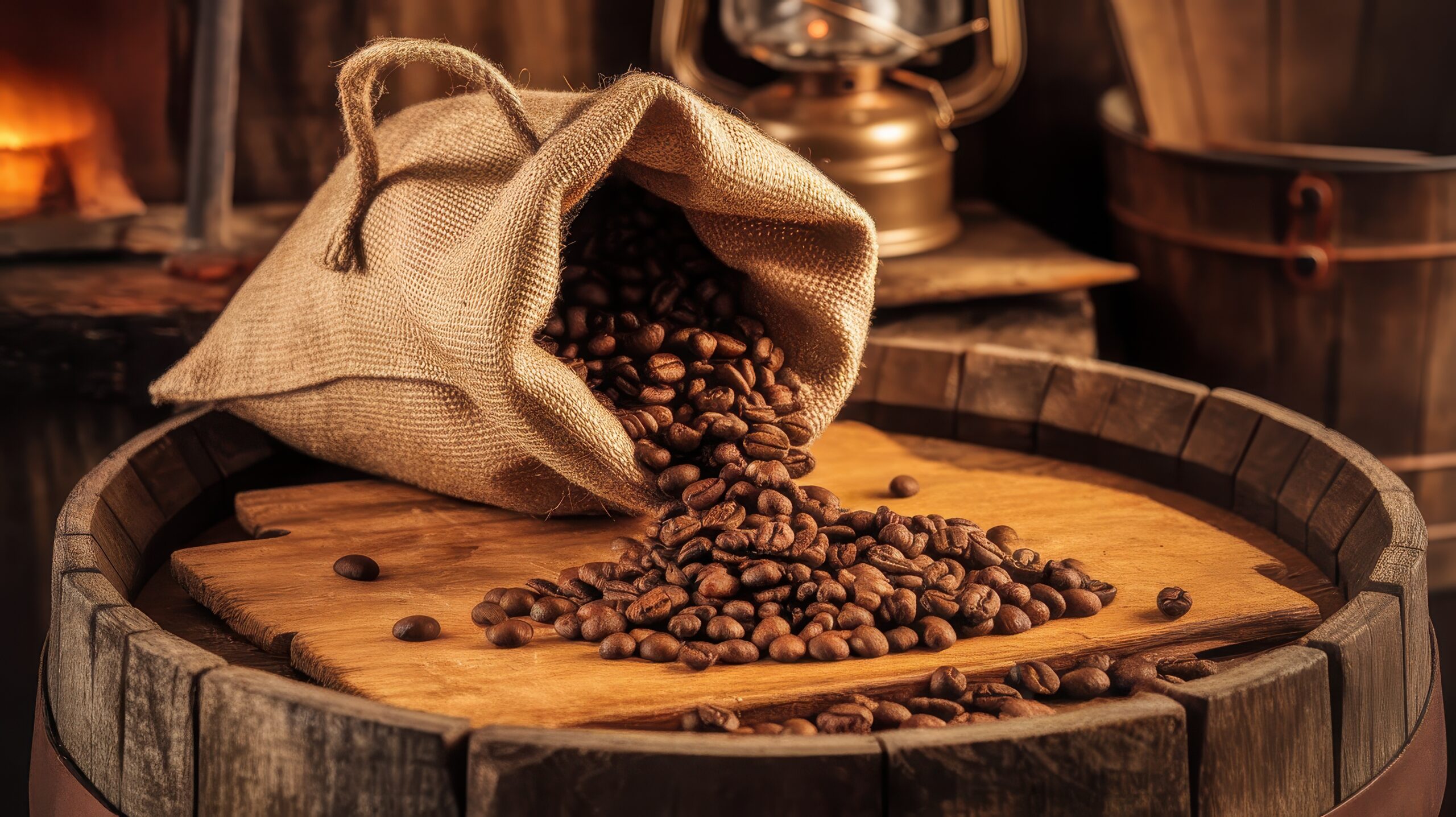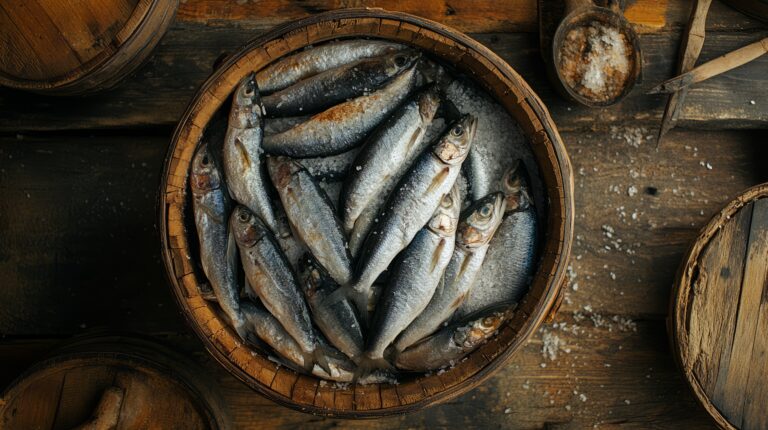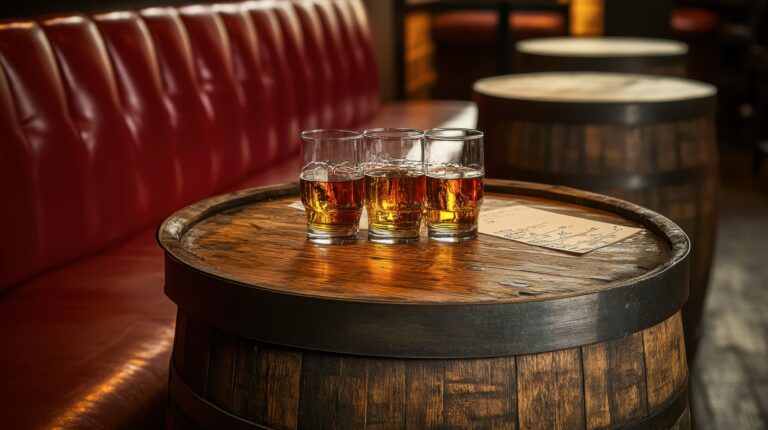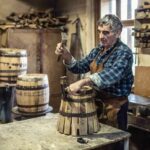You ever think about how aging whiskey in a barrel changes its flavor? Well, coffee roasters are doing the same thing, and the results are pretty amazing. They’re getting super creative, using different aging techniques to create totally new and complex flavor profiles. One of the coolest methods is aging green coffee beans in used whiskey barrels. The wood from the barrels soaks into the beans, giving them notes of vanilla, caramel, and oak, along with subtle hints of the whiskey that used to call that barrel home. The final product? A coffee experience you won’t find anywhere else.
The Rise of Barrel-Aged Coffee
Barrel-aged coffee is one of the most exciting new trends in the coffee world. Roasters have started aging green coffee beans in whiskey barrels before roasting them. The beans absorb the leftover flavors from the barrel, creating a coffee with rich, complex notes of caramel, vanilla, oak, and spice.
These specialty barrel-aged coffees are becoming a huge hit with both coffee lovers and whiskey drinkers. The unique flavors create an experience that’s truly one-of-a-kind. Roasters can age the beans for different amounts of time depending on how strong they want the flavors to be. The longer the beans age, the more intense the whiskey notes become. Some roasters even age beans for up to three years to get the maximum flavor!
While the bourbon barrel-aged coffee trend started in the US, roasters all over the world have jumped on board. Now, you can find barrel-aged coffees that have been aged in rum, brandy, wine, and port barrels. The different spirits create a huge range of flavor profiles, from fruity and bold to smooth and sweet. If you’re looking to try some, check out Bow & Arrow’s Ethiopia Gedeb bourbon barrel-aged coffee, which has hints of dark chocolate, raisins, and oak. Or try Kona Rainforest’s Kona “Port Cask,” aged in port wine barrels, with flavors of nuts, dark fruit, and toffee.
Even though barrel-aging is still a niche market, it really shows how creative and daring the specialty coffee industry has become. What will they come up with next? If you want a truly unforgettable coffee, you have to try one of these barrel-aged coffees. Your taste buds will thank you.
How Whiskey Barrel-Aging Changes Coffee Flavor
Coffee and whiskey—two of the best things in life, now together in one amazing blend. Whiskey barrel-aged coffee is the latest trend for adventurous coffee drinkers who want to experience classic flavors in a brand new way.
How does barrel-aging change the flavor?
As the green coffee beans sit in the whiskey barrel, they absorb the rich, complex flavors soaked into the wood. The beans take on notes of vanilla, caramel, and oak. The longer they age, the more flavor they absorb. Some roasters age the beans for just a few weeks, while others let them sit for months to create a super intense, bold flavor.
The aging process also mellows out the coffee’s acidity and gives it a smoky finish, similar to a peaty whiskey. The beans even turn a gorgeous amber color from the barrel’s wood. When you finally grind and brew the aged beans, all that complex, layered flavor is released into your cup.
The perfect pairing
For the ultimate experience, many whiskey barrel coffee roasters suggest adding a splash of the same whiskey used to age the beans. The complementary flavors create a beautiful harmony in your cup. Others prefer to drink the coffee black to fully appreciate how the aging process completely transformed the beans. Either way, whiskey barrel-aged coffee is meant to be enjoyed slowly and savored.
Innovation leading to new creations
The success of whiskey barrel-aging has inspired roasters to start experimenting with aging beans in rum, wine, and tequila barrels. A few creative roasters are even blending different barrel-aged coffees to create unique flavor combinations. This fusion of coffee and spirits is a trend that will definitely continue to grow and inspire new taste sensations. Coffee that tastes like dessert? What’s not to love?
Other Popular Barrel-Aging Methods for Coffee
As the specialty coffee world continues to push the limits of new flavors and experiences, barrel-aging coffee beans has become more and more popular. Coffee beans are aged in used whiskey, rum, or wine barrels to infuse them with complex flavors before they’re roasted and brewed.
Whiskey Barrels
Aging coffee beans in used whiskey barrels gives them flavors of vanilla, oak, and caramel, along with subtle hints of the whiskey itself. The amount of time the beans spend aging in the barrel determines how strong the whiskey flavor notes become. As little as a few weeks up to several months will have a noticeable effect. Some roasters find that aging for 6-12 weeks provides the perfect balance of coffee and whiskey flavors.
Rum Barrels
For a sweeter, rum-flavored coffee, aging green coffee beans in used rum barrels is the way to go. The barrels, which often held spiced or coconut-infused rum, will give the coffee complementary flavors. Rum barrels add notes of brown sugar, tropical fruit, vanilla, and a touch of molasses. Just like with whiskey barrel-aging, the longer the beans age, the more prominent the rum flavors will be in your final cup.
Wine Barrels
Aging coffee beans in used wine barrels, often from Cabernet Sauvignon, Merlot, or Pinot Noir, creates a fruity coffee with hints of berry, cherry, and currant. The tannins from the wine barrels also add subtle notes of cedar and tobacco leaf. Wine barrel-aging usually produces a more delicate flavor than whiskey or rum barrel-aging and requires at least 2-3 months to have a noticeable effect.
Other spirits used for barrel-aging coffee include tequila, bourbon, and brandy. As barrel-aged coffee continues to gain popularity, roasters are experimenting with different barrel types and aging techniques to create innovative and memorable coffee experiences for daring coffee drinkers. The possibilities for discovering new flavors through barrel-aging are endless!
Cold Brew Coffee: A Refreshing Innovation
Cold brew coffee is a new spin on classic iced coffee. To make it, you steep coarse-ground coffee beans in cold or room-temperature water for 12 to 24 hours. The long steeping time allows the water to absorb the coffee oils and flavors without the bitterness you get from using hot water. The result is a smooth, rich, and naturally sweet concentrate you can drink on its own over ice or use as the base for other coffee drinks.
A Growing Trend
Cold brew coffee has become super popular recently. Its smooth, mellow flavor appeals to people looking for an alternative to the acidity of hot-brewed coffee. The cold brewing process also allows unique flavor notes to shine through because the compounds responsible for bitterness and acidity aren’t extracted by the cold water. The lower acidity of cold brew also makes it a good option for people with sensitive stomachs or acid reflux from regular coffee.
Beyond Black Coffee
While delicious on its own, cold brew coffee can also be the base for a bunch of different coffee drinks. Add milk or a non-dairy alternative for a creamy cold brew latte, or add chocolate or caramel syrup for a delicious treat. For an adult drink, combine cold brew concentrate with bourbon, rum, or vodka and your choice of mixers. The mild, naturally sweet flavor of cold brew pairs really well with spirits and helps create a perfectly balanced cocktail.
Cold brew coffee is an exciting innovation in the coffee world. Its unique flavor and versatility have helped it become a mainstream hit and cemented its place as a new coffee classic. Whether you prefer your cold brew black or in a cocktail, its smooth and mellow taste is sure to hit the spot.
Nitro Coffee: Velvety Smooth and Cascading
Nitro coffee is cold brew coffee infused with nitrogen gas, which gives it a creamy mouthfeel and a beautiful cascading look when it’s poured. The nitrogen infusion creates tiny bubbles that change the texture of the coffee, making it much silkier than regular cold brew.
A Mesmerizing Pour
When nitro coffee is poured, it looks just like a stout beer being pulled from the tap, with a frothy layer of creamy coffee bubbles that cascade down the side of the glass. This beautiful pour is a big part of the experience. The nitrogen also helps keep the coffee fresh for up to 5 days.
A Smooth Taste
The nitrogen infusion gives nitro coffee an incredibly smooth taste without the bitterness you sometimes get from cold brew. The coffee tastes richer and fuller, with subtle chocolatey notes. The creamy texture coats your mouth, making the flavor experience even better.
Growing in Popularity
First popularized in 2015, nitro coffee has become a mainstream hit and is now offered at many specialty coffee shops and roasters. You can even buy home nitro coffee makers, so you can easily make it at home.
Health Benefits
Nitro coffee still has all the health benefits of regular cold brew coffee, including lower acidity and a higher caffeine content. The nitrogen infusion doesn’t remove any of the antioxidants or beneficial compounds found in coffee.
Have you tried this innovative new way to experience coffee? Nitro coffee is a fun change from your regular hot or iced coffee routine. With its mesmerizing pour, velvety smooth taste, and cascade of tiny bubbles, nitro coffee creates a coffee drinking experience unlike any other. Find out why this cold brew coffee trend continues to gain popularity and try some nitro coffee for yourself.
The Third Wave of Specialty Coffee
The third wave of specialty coffee is all about premium, small-batch coffee you can trace back to the farm where the beans were grown. People want to know the origin and growing practices behind their coffee. They expect sustainably and ethically sourced beans that are turned into a quality product.
Roasters want to highlight the unique flavor profiles of single-origin beans. They carefully select, roast, and blend beans to get the best aroma, acidity, body, and other flavor notes. Barrel-aging coffee beans adds another layer of flavor complexity.
Whiskey barrel-aged coffee beans are aged in charred oak barrels that previously held whiskey. They absorb flavors from the wood like vanilla, caramel, and oak, plus subtle whiskey undertones. The beans are then roasted and ground to create an incredibly flavorful cup of coffee with hints of whiskey.
Rum barrel-aged coffee gives you tropical, molasses-like flavors. Tequila barrel-aging adds vegetal, agave notes. Gin barrel-aging results in citrusy, juniper accents. The options are endless for creative coffee roasters and distillers.
Coffee connoisseurs seek out these innovative specialty coffees. Local craft roasters and small-batch distilleries often work together to produce barrel-aged coffees as exclusive, limited releases. They usually sell out fast because of the high demand from both coffee and spirits lovers.
The third wave specialty coffee movement encourages people to appreciate the nuanced flavors you can get from high-quality coffee beans. Barrel-aging is just one way creative roasters are continuing to push the boundaries of coffee in new and unexpected directions. The next big innovation might be right around the corner.
Coffee Brewing Methods: Pour Over, French Press, and More
When it comes to brewing coffee, the options seem endless these days. Here are some of the most popular methods for making your morning joe.
Pour Over
This simple method involves pouring hot water over fresh grounds in a filter to make a single cup of coffee. All you need is a pour over dripper, a filter, and a kettle. The Chemex and Hario V60 are popular pour over drippers known for making a clean, flavorful cup of coffee. The trick is using the right grind size and water temperature to get the best flavor from the beans.
French Press
The French press, also called a press pot, uses a mesh plunger to push coffee grounds to the bottom of a cylindrical pot. Just add coarse-ground coffee and hot water, steep, then plunge. The result is a bold, rich cup of coffee with an earthy, full-bodied flavor. The French press allows oils and sediment to pass through the mesh filter, giving you more depth of flavor.
Cold Brew
For a refreshing summer coffee, try cold brewing. Coarse-ground coffee is steeped in cold or room-temperature water for 12 to 24 hours. The long, slow brewing process results in a coffee concentrate that you can dilute with water or milk over ice. The cold brewing method produces a naturally sweet coffee with chocolatey, nutty notes. You can store it in the fridge for up to two weeks.
Espresso
Espresso is made by forcing hot water or steam through finely ground coffee beans. The result is a concentrated shot of coffee with a thick layer of creamy foam on top called crema. Espresso is the base for popular coffee drinks like lattes, cappuccinos, and macchiatos. Making a good espresso requires an espresso machine to properly extract the coffee at high pressure. Espresso has an intense, robust flavor with notes of caramel and nuts.
The variety of coffee brewing methods gives you endless options to experience the complexity of flavors in coffee. Try different methods to find your perfect cup of joe. Whether you prefer a clean pour over, a rich French press, a refreshing cold brew, or an intense espresso, there’s a brewing method for every taste.
Coffee Meets Technology: Apps and Gadgets for Coffee Lovers
Coffee geeks, your time has come. You no longer have to rely on sight and smell alone to know if your coffee is perfect. Mobile apps and gadgets are making the coffee experience even better, from how we buy and make coffee to how we can analyze the results.
Mobile Payment
Paying for your coffee fix has never been easier thanks to mobile payment apps like Starbucks, Dunkin’ Donuts, and brewing equipment brands like Breville and Keurig. No need to dig in your wallet for cash or swipe a credit card. Just open the app, scan, and pay. Some apps even let you order ahead so you can skip the line.
Smart Coffee Makers
If you’d rather make specialty coffee at home, smart coffee makers can help you get barista-level results. High-tech machines like the Breville Oracle and Oracle Touch use digital temperature control and automatic tamping and steaming for espresso. The Brewista Smart Scale gives you feedback on water volume and flow rate for perfect pour-over coffee. Connected coffee makers from brands like Keurig, Nespresso, and Smarter let you start your coffee from your phone, so it’s ready when you wake up.
Taste Analyzing Apps
How do you know if you’ve hit the perfect balance of flavors in your coffee? Taste analyzing apps claim to have the answer. Bean Scanner and Coffee Taster use color analysis to detect quality, intensity, acidity, body, and more. But these apps rely on your phone’s camera, so the results can be subjective. For a more objective analysis, the handheld SCAA Coffee Taster’s Flavor Wheel provides a standardized flavor lexicon to help you describe what you’re tasting.
While technology will probably never replace the simple pleasure of enjoying a cup of coffee, these innovations can definitely enhance your experience, whether you’re a casual coffee drinker or a craft connoisseur. The future of coffee is here.
What’s Next? Upcoming Coffee Innovations to Watch For
The coffee industry is innovating at an incredible pace. Here are some of the most exciting new trends to keep an eye on:
Barrel-Aging Coffee
Aged bourbon isn’t the only thing that gets better with time in oak barrels. Roasters are experimenting with aging green coffee beans in used whiskey barrels before roasting them. The beans absorb flavors from the barrel like vanilla, caramel, and oak. The results are coffees with tasting notes of cocoa, molasses, and toasted nuts.
Cascara Tea
Cascara is the dried husk of the coffee cherry fruit. It has a tangy, fruity flavor and is packed with antioxidants. Cascara can be brewed into a tea-like drink or used as an ingredient in cocktails. As the demand for sustainable, zero-waste products grows, cascara is becoming more popular.
Mushroom Coffee
Certain mushrooms like chaga, cordyceps, and lion’s mane are praised as “superfoods” for their health benefits. Some companies are blending powdered mushrooms with coffee to create mushroom coffee or mushroom lattes. The mushrooms are said to improve focus and cognition. While the hype is a bit controversial, mushroom coffee is definitely an interesting idea.
Nitro Coffee
Nitro coffee is cold brew coffee infused with nitrogen gas, which gives it a frothy, Guinness-like head and a smooth, creamy mouthfeel. Nitro taps that dispense nitro coffee, nitro lattes, and other nitro coffee drinks are popping up in coffee shops everywhere. You can even buy home nitro coffee makers. The rise of both craft coffee and craft beer is fueling interest in nitro coffee.
Hemp Milk Lattes
Hemp milk is a dairy-free alternative made from hemp seeds. With a creamy texture and nutty flavor, hemp milk works great in coffee drinks. More and more coffee shops are now offering hemp milk lattes, cappuccinos, and other espresso drinks made with it. The rise of plant-based diets and non-dairy milk options has definitely boosted the popularity of hemp milk and hemp milk coffee drinks.
The future of coffee is looking bright, with no shortage of new and exciting innovations on the horizon. Coffee lovers have a lot to look forward to!
Final Thoughts
So there you have it, a taste of some of the latest innovations happening in the coffee world. Barrel-aging coffee beans to give them complex flavors is really pushing the limits of what we thought was possible with coffee. Cold brew and nitro coffee give you new ways to enjoy your daily caffeine fix. And with single-origin beans and micro-roasters continuing to spread, you have more options than ever to explore. The coffee scene is changing fast, with passionate artisans creating brews as diverse and complex as fine wines. Whether you like your coffee black or with a silky foam on top, there’s an exciting new coffee experience out there just waiting to be discovered. So go on, try something new—your taste buds will definitely thank you.







